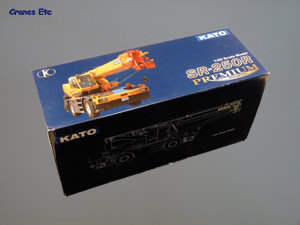 | | The box. |  | 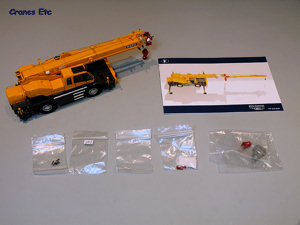 | | The parts out of the box. | 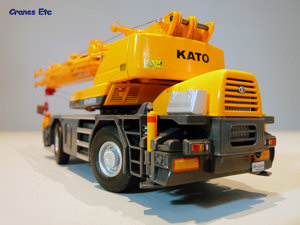 | | Rear view. | 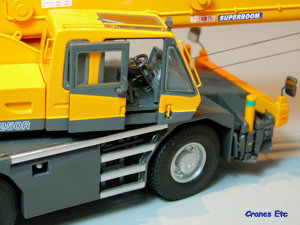 | | Opening cab door and highly detailed operator's station. | 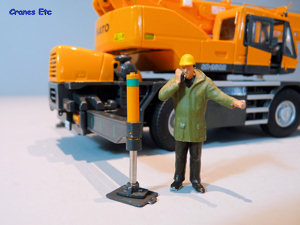 | | Metal outriggers and realistic pistons. | 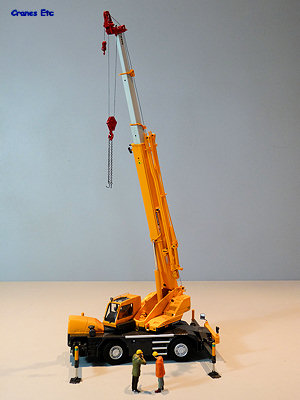 | | Ready to lift. | 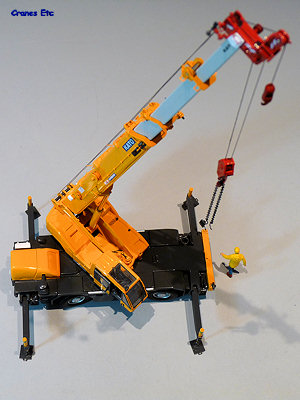 | | Straight boom sections. | 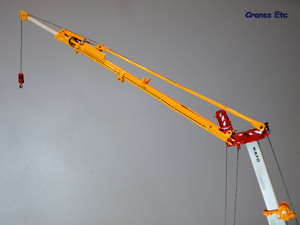 | | The fly jib set at an offset angle and partially telescoped. | 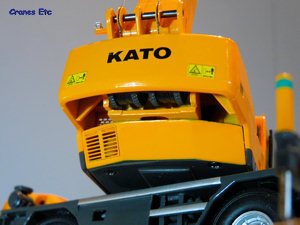 | | Winch drums are accessed from underneath. | 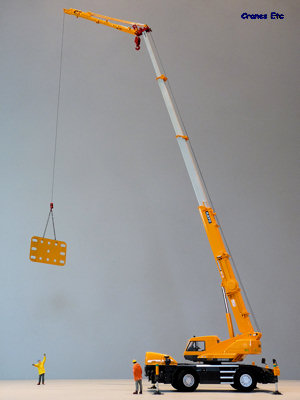 | | Lifting a load. |
| Kato is a Japanese company founded in 1895 which employs over 500 people. It manufactures a range of mobile cranes, and also hydraulic excavators, earth boring machines and sweepers.
The SR-250R is a rough terrain mobile crane with a 25 tonne maximum lifting capacity.
Packaging
This model continues YCC's tradition of providing very high quality packing. The picture box has a photo and line diagrams of the real machine, although there is no other information. It covers a high quality plain black box which contains the model. Inside the crane is contained within black foam rubber, and sits in its own plastic tray and this is placed with ribbon underneath, which, when pulled, lifts the model out easily.
There were no defects or missing parts on the review model.
A small brochure is included. This pictorially shows the main features of the model and is good enough, although a complete novice would probably prefer some written instructions also. Assembly of the small pieces is straightforward and the main hook is already reeved. The single line hook block has to be reeved and this needs good eyesight, a steady hand and a calm temperament.
Detail
This is a highly detailed model with some very precise and fine modelling work. However this also means the model has to be treated with respect as some of the smaller parts fixed to the model will not survive rough handling.
The underside of the model is fully detailed with transmission components and features such as a fuel tank although there are no hoses running to the axles as seen on some models. The tyres are really good and they have 'Bridgestone' contained within the tyre wall which is a great detail, and is matched by the detailing of the hubs.
The carrier is generally excellent. Small details such as the fuel tank filler are present and there is some very fine hoses running to the outrigger beams. At the front there is a holder for the single line hook block, and the lights are made up of very good plastic lenses. A pair of adjustable mirrors sit on the front beam. The outrigger beams are metal and are accurately marked with the various extension points as on the real crane. The outrigger cylinders look realistic and thankfully no screw threads are visible. A superb detail is the provision of four small plates for the outrigger pads to sit on. They are metal and have tiny handles. At the rear the engine block is well modelled with the air cleaner made of metal. The detail is completed with a small cabinet.
The operator's cab is a master work. Extremely fine metal grab rails adorn the cab and the windscreen wipers are of a similarly fine quality. Detail inside the cab is also excellent with the control console having switches and dials authentically reproduced. The rest of the crane body is cast well, with good quality grilles and very small graphics. Other details worthy of note are the slewing motors with hydraulic hoses, and a small loop for attaching the main hook whilst travelling.
The boom is the most detailed yet seen on a rough terrain mobile crane as at the time of the review. Hydraulic lines are beautifully rendered and the cable spool is metal. Guides for the ropes at the top of the first boom section contain pulleys which are amazing for their tiny size. Some of the grab handles and other details are exceptionally thin. The detail level continues at the boom head where in addition to metal pulleys, there is an anemometer for measuring wind speed, and a mirror. A small runner fits to the boom head.
The fly jib is another piece of excellent diecast work. It has first class hydraulic lines cast in, and these lead to the luffing cylinder. All the parts of the jib are metal, but there has been no loss of detail as a result.
Two hooks are supplied. The main block has three metal pulleys, and the hook rotates in the block and has a safety latch. The single line block is nicely detailed and has a moving hook.
Features
The axles steer independently although the range of movement is fairly limited. Both axles also have working suspension.
The outrigger beams can be set at various extensions, and the pads can be lowered and will support the crane's weight. Separate small plates can be deployed and these are stored in pockets on the crane for transport.
The engine cover tilts open and reveals a detailed engine. The operator's cab door also opens and correctly reproduces the pull out and slide motion of the real door which is a remarkable achievement. A smaller but pleasing feature is that the mirrors on the front beam can be rotated and folded in to narrow the width for transporting the crane on a low loader.
All the usual crane functions work well. It rotates and the boom can be lifted and extended. The main cylinder holds the boom's weight but will bleed down at a shallow angle or under load. Both winches are operated by rotating the winch drums underneath the body. This works fine, although care must be taken to not let the thread come off of the drums and get tangled outside on the spindles.
A small runner can be fitted to the end of the boom for the single line block, and the fly jib can also be attached. The fly jib is telescopic and can also be luffed using the cylinder although it is not stiff enough to hold much load. When not in use the fly jib is attached to the main boom using very small plastic pins.
Quality
YCC have maintained their reputation for high quality with this model. Metal is used almost everywhere and some of the workmanship is very fine indeed. The paintwork is very good as are the graphics.
Price
This model is relatively pricey for a two axle crane but it is good value for the quality that it offers.
Overall
Kato can be very pleased with this YCC rendition of one of their popular cranes. Collectors will be equally pleased as this model is one of the most detailed and accurate modelled cranes available. This is a very high quality model and it easily deserves an 'Outstanding' rating.
Footnotes
The model first appeared as a prototype at the Nuremberg Toy Fair in February 2009. It appeared at dealers from August 2009. In February 2010 two limited edition versions appeared. One in silver in a run of 150 models, and the other in the colours of 'Uchimiya' (orange and white) in a run of 100 models. |
| |
| 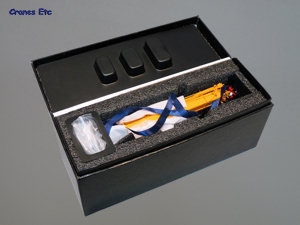 | | The box is top quality with foam rubber, and ribbons to enable the model to be lifted out. | 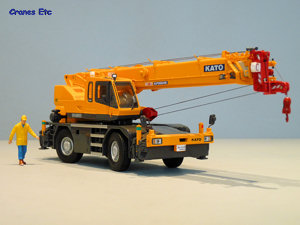 | | Both axles steer. | 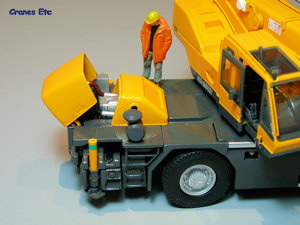 | | Opening engine cover. | 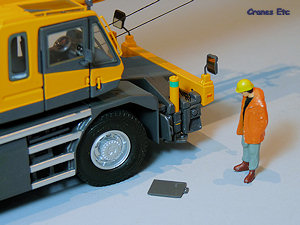 | | Small plates for the outrigger pads pull out from a storage rack. | 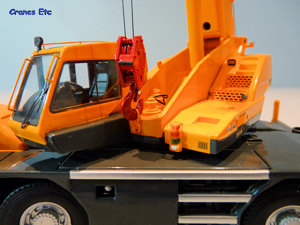 | | Loop for hooking up during travelling. | 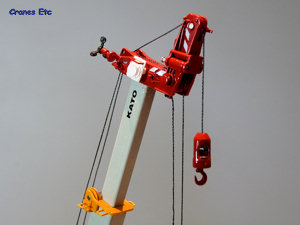 | | Very detailed boom head with the optional runner fitted. | 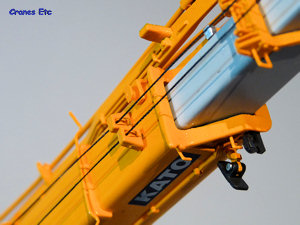 | | Two of the smallest pulleys ever seen on a 1:50 scale model. | 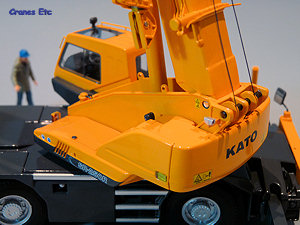 | | Body details. | 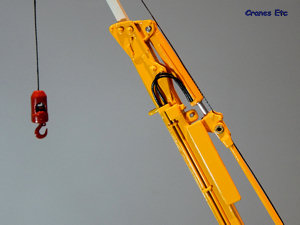 | | Detailed hydraulic luffing gear for the fly jib has hosing. | 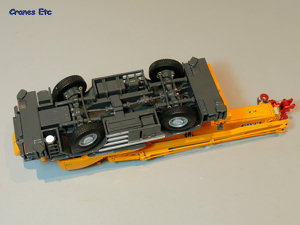 | | Underside view. | 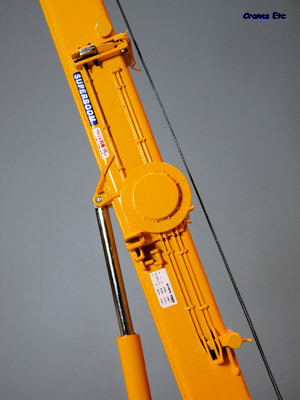 | | Highly detailed boom. | 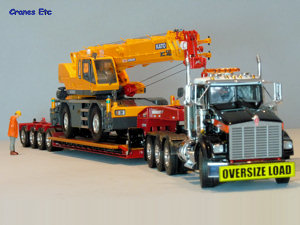 | | The Kato transported on a Rogers Lowboy. |
|

